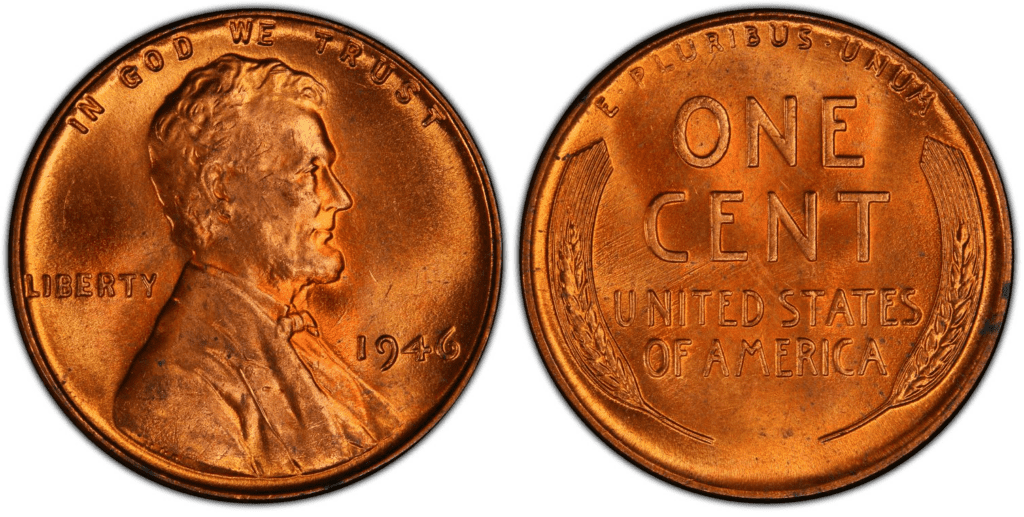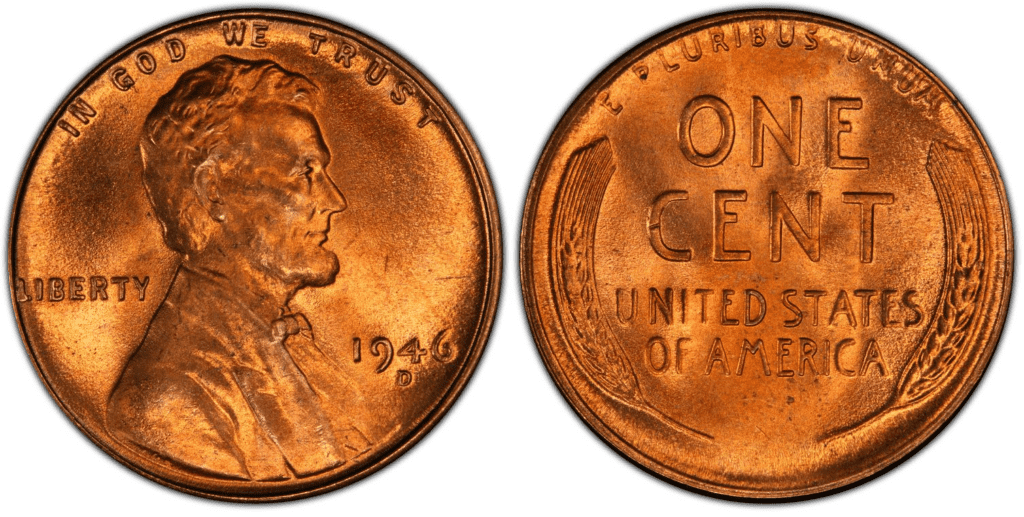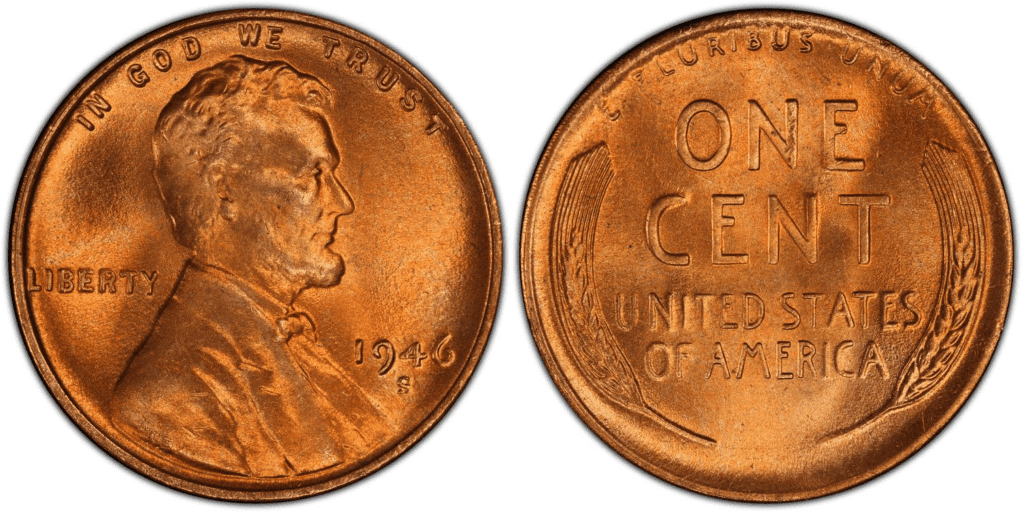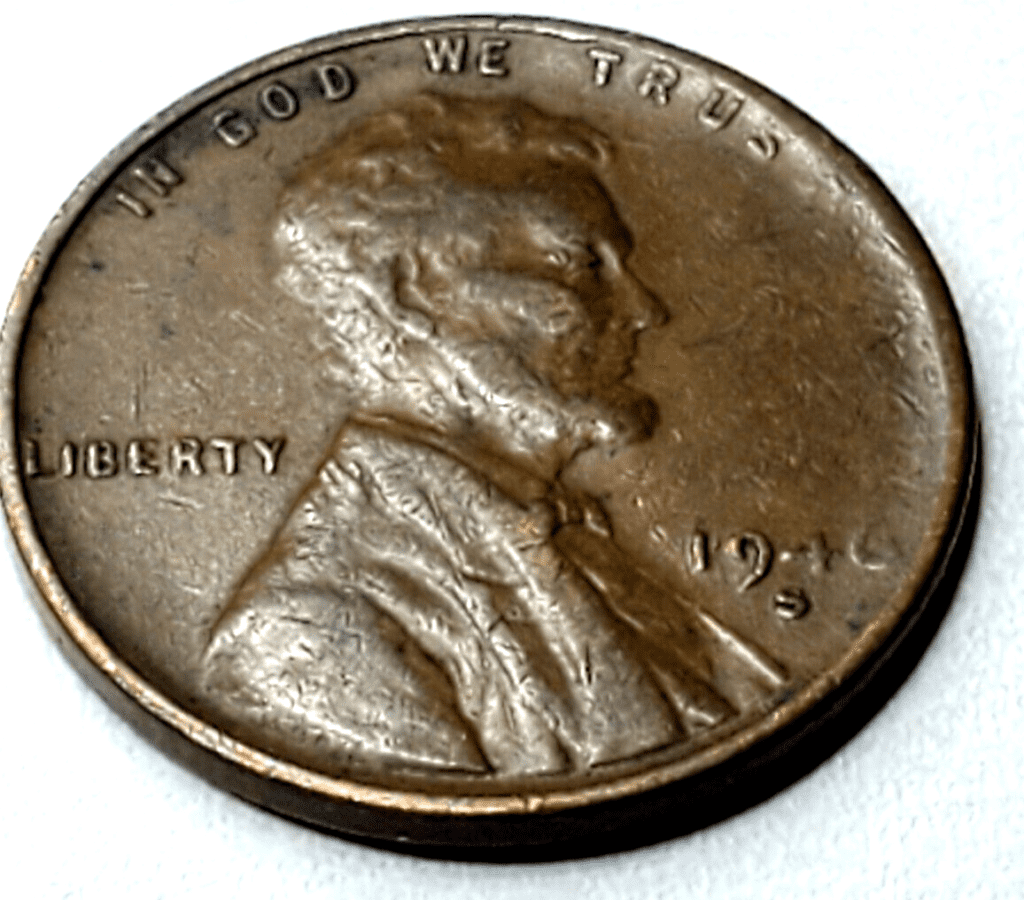What Is the 1946 Lincoln Wheat Penny Made Of?
Do you have an interest in collecting coins issued in the 1940s? If so, then you’re in the right place! In this guide, we will discuss the 1946 Lincoln Wheat Penny. Read on to learn more about its composition, history, varieties, price value, and more.
The face value of the Lincoln cent (a.k.a Lincoln Penny) is $0.01. The U.S. Mint began to strike the Lincoln Penny in 1909. For over a century, the Mint has been producing coins for circulation. The record shows that the U.S. Mint produced over 1.5 billion Lincoln Wheat Penny just in 1946.
The materials used to make the 1946 Lincoln Wheat Penny were 95 percent copper and a 5 percent mixture of tin and zinc. The same metal composition and proportion were used for the cents produced in 1909-1942 and 1944-1982. The Mint only used zinc-plated steel materials for the Lincoln cents in 1943 because there were shortages of copper during the war.
Since 1982, the U.S. Mint has used the 97.5% zinc and 2.5% copper combination for all the Lincoln pennies.
Regarding its general specifications, you can see that the 1946 Lincoln cent has a plain edge, and its diameter is 19.05 mm. The cents minted from 1909 to 1982 (including the 1946 series) weighed 3.11 grams. Meanwhile, the Lincoln pennies struck in 1943 (wartime steel coins) weighed 2.7 grams. However, all coins at this current age weigh 2.5 grams.

Did you know that Victor David Brenner is not the original sculptor commissioned to design the Lincoln cent? Initially, the one-cent design was a flying eagle created by sculptor Augustus Saint-Gaudens, but later on, then-president Theodore Roosevelt learned that by law, an eagle could not appear on the coin.
So they have decided to redesign the coin. However, Saint-Gaudens became ill and died without finishing the coin’s obverse design. The inception of having Lincoln on the one-cent in 1909 happened when many citizens proposed this to the Treasury Department. Roosevelt was also interested in giving honor to his fellow Republicans.
Then in January 1909, Brenner was ordered to begin the coinage redesign to have Lincoln’s profile on the cent. Having the then-assassinated president on the coin was timely, being 1909 was also his centennial birth anniversary (he was born on February 12, 1809).
On the obverse (heads) of the 1946 Lincoln Wheat, you can see the bust of the 16th U.S. President Abraham Lincoln facing right. The inscriptions that can also be found on the obverse side are the following:
- IN GOD WE TRUST
- LIBERTY
- 1946
On the reverse (tail), Brenner depicted the two stalks of wheat placed on the left and right sides of the coin. You can read the following inscriptions as well:
- E PLURIBUS UNUM
- ONE CENT
- UNITED STATES OF AMERICA
Brenner designed two ears of durum wheat in the 1946 cent, which made the Lincoln coins known as ‘wheat pennies.’ The coins struck between 1909 and 1958 have a wheat design on them. In 1959, Brenner’s wheat was replaced with the Lincoln Memorial, designed by Frank Gasparro.
1946 Lincoln Wheat Penny Varieties
The three mints in the U.S. (i.e., in Denver, Philadelphia, and San Francisco) massively produced the three varieties of the 1946 Lincoln Penny. These varieties available were 1946-D, 1946-P, and 1946-S.
The combined coins struck and minted that year reached over 1.5 billion cents. Of these, there were also minted-error coins produced.
Each of these varieties has details as described below:
1946 D Lincoln Wheat Penny
Edge: Plain
Mint Mark: D
Place of minting: Denver
Year of minting: 1946
Face Value: $0.01 (one cent)
Price: $0.50 to $15 (or more)
Quantity produced: 315,690,000
Designer: Victor David Brenner
Composition: 95% Copper and 5% Tin and Zinc
Mass: 3.11 grams
Diameter: 19.05 mm

The Denver Mint produced about 316 million Lincoln cents for release and circulation in 1946. This Mint’s production was the 10th highest in the series. This number makes the 1946 pennies abundant on the rarity scale.
1946 P Lincoln Wheat Penny
Edge: Plain
Mint Mark: No mint mark
Place of minting: Philadelphia
Year of minting: 1946
Face Value: $0.01 (one cent)
Price: $0.50 to $17 (or more)
Quantity produced: 991,655,000
Designer: Victor David Brenner
Composition: 95% Copper and 5% Tin and Zinc
Mass: 3.11 grams
Diameter: 19.05 mm

More than 991 million pennies were struck at the Mint in Philadelphia in 1946. This impressive number was the 5th highest of the wheat series. This is the same for the 1946-D; this variety is also abundant on the rarity scale.
1946 S Lincoln Wheat Penny
Edge: Plain
Mint Mark: S
Place of minting: San Francisco
Year of minting: 1946
Face Value: $0.01 (one cent)
Price: $0.50 to $12 (or more)
Quantity produced: 198,100,000
Designer: Victor David Brenner
Composition: 95% Copper and 5% Tin and Zinc
Mass: 3.11 grams
Diameter: 19.05 mm

In 1946, the San Francisco mint struck nearly 200 million wheat pennies for release and circulation. This variety has a more Abundant rarity scale and a significant number of Good to Fine grade coins. Most sought after by collectors are the well-defined coins. Some collectors also look at the pennies with separate lines on the wheat stalks.
List Of 1946 Lincoln Wheat Penny Errors
Out of the 1.5 billion plus pennies struck in 1946, you could expect that there would be mint-error coins produced. When the equipment is overworked, it could deteriorate its performance, resulting in error coins.
As these errors are uncommon, the unique result increases the coin’s value, making it more attractive to many coin collectors. As a result, distinct and special coins are usually worth a premium when sold.
Many types of errors can occur during minting. Some of them are listed below:
- Die crack
- Rotated die
- Doubled die
- Clipped planchet
- Bank planchet
- Weak strike
- Off-center strike
- Broadstrike
- Lamination error
Let’s take a look at some samples of the error coins produced in 1946 below:
Die Break

As you can see in this example, there is a cut through the bust of Lincoln. Die breaks cross the bust’s face from rim to rim. It shows that one side of the break is slightly higher than the other.
Edge and rim errors

This 1946 Wheat coin is a sample of an edge and rim error showing the right side rim of the penny has no edge. The letter T from the word Trust is not visible, and the number 6 from 1946 is faded. A planchet (cent blank) is surrounded by collars when struck. The collars help prevent the blank cent from flattening and spreading. So edge and rim errors will occur when collars deteriorate or are out of position.
Broadstrike

The 1946 wheat cent above is an example of broadstrike error. The coin has a chin of Lincoln being doubled and off-centered. Broadstrike error occurs when the circular die that surrounds the lower die (collar die) malfunctions. As a result, the planchet’s metal is prevented from flowing outside the confines of the die. Coins with broadstrike error usually have plain edges.
How Much Is The 1946 Lincoln Wheat Penny Worth Today?
Most coin experts and numismatists are fascinated with coins with their excellent condition, grade, and rarity. So they put much value on the 1946 Lincoln wheat penny in a higher grade. However, when it comes to the cent’s melting value, this is based on the value of the metals it is made of.
Today, the value of a 1946 Lincoln wheat cent is approximately $0.0249739. This is based on the price value of the 95% copper and 5% zinc mixture.
Though its face value is almost insignificant, those Uncirculated coins or Extremely Fine pieces are still sought after. If you look at the chart below, you can get an idea of how much a 1946 wheat coin is valued based on its type and condition.
| Coin | Condition | Grade | Mintage | Value |
| 1946 D Lincoln penny | Circulated/Mint | Not graded | 315,690,000 | $0.15 to $6 |
| 1946 D Lincoln penny | Uncirculated/Mint | MS-65 | 315,690,000 | $11 to $69 |
| 1946 D Lincoln penny | Uncirculated/Mint | MS-66 | 315,690,000 | $16 to $36 |
| 1946 D Lincoln penny | Uncirculated/Mint | MS-67 | 315,690,000 | $102 to 312 |
| 1946 P Lincoln penny | Circulated/Mint | Not graded | 991,655,000 | $0.15 to $4
|
| 1946 P Lincoln penny | Uncirculated/Mint | MS-65 | 991,655,000 | $10 to $210 |
| 1946 P Lincoln penny | Uncirculated/Mint | MS-66 | 991,655,000 | $31 to $120 |
| 1946 P Lincoln penny | Uncirculated/Mint | MS-67 | 991,655,000 | $288 to $1,001 |
| 1946 S Lincoln penny | Circulated/Mint | Not graded | 198,100,000 | $0.15 to $6
|
| 1946 S Lincoln penny | Uncirculated/Mint | MS-65 | 198,100,000 | $7 to $43 |
| 1946 S Lincoln penny | Uncirculated/Mint | MS-66 | 198,100,000 | $11 to $30 |
| 1946 S Lincoln penny | Uncirculated/Mint | MS-67 | 198,100,000 | $91 to $2,640 |
As you can see, the 1946 wheat penny can astronomically be more valuable than its face value and melt value. To know how much this coin is worth, check out the following auction records:
- $14,950 – a 1946 1C, R.D. (Regular Strike) with a grade of MS67 sold in January 2006 by Heritage Auctions
- $6,169 – a 1946-S 1C, R.D. (Regular Strike) coin with a grade of MS67+RD sold in March 2016 by Heritage Auctions
- $2,585 – a 1946-D 1C, R.D. (Regular Strike) coin with a grade of MS67 sold in February 2014 by Heritage Auctions
How Does The Grading System Work?
The Sheldon Scale is used by numismatists to provide a numerical value to coins. The Sheldon Scale goes from poor (P-1) to perfect mint state (P-1) (MS-70). Coins were originally evaluated using words to reflect their condition (Good, Fair, Excellent, Etc.). Unfortunately, coin collectors and dealers had different ideas about what each of these terms represent.
Professional numismatists joined together in the 1970s and established CoinGrading standards. These numismatists now assign grades at key places on the seventy-point scale, using the most regularly utilized numeric points in conjunction with the original adjective grade. The following are the most common coin grades:
-
-
- (P-1) Poor – Indistinguishable and probably damaged; if used, must have a date and mintmark; otherwise, rather battered.
- (FR-2) Fair – Nearly smooth, but without the damage that a coin graded Poor often possesses. The coin must have enough detail to be identified.
- (G-4) Fair – Inscriptions have merged into the rims in some areas, and important elements have been mostly erased.
- (VG-8) Very Good- A little weathered, but all of the primary design elements are visible, albeit faintly. There is little if any, central detail left.
- (F-12) Good – The item is very worn, yet the wear is even, and the overall design details stand out clearly. Rims are almost completely isolated from the field.
- (VF-20) Very Fine – Moderately weathered, with some finer features still visible. The motto or all letters of LIBERTY are readable. Both sides of the coin have entire rims that are separated from the field.
- (EF-40) Extremely Fine – Gently used; all gadgets are visible, and the most important ones are bold. The finer details are bold and clear, however, light wear may be seen.
- (AU-50) Uncirculated – Slight evidence of wear on the coin’s design’s high points; may have contact marks; eye appeal should be adequate.
- (AU-58) Uncirculated Choice – Slight traces of wear, no severe contact marks, almost full mint shine, and great eye appeal.
- (MS-60) Mint State Basal – Strictly uncirculated; no indication of wear on the coin’s highest points, but an unsightly coin with reduced luster, visible contact marks, hairlines, and other flaws.
- (MS-63) Mint State Acceptable – Uncirculated, but with contact scratches and nicks, little reduced shine, but otherwise appealing appearance. The strike is weak to average.
- (MS-65) Mint State Choice – Uncirculated with great mint shine, very little contact blemishes, and exceptional eye appeal. The strike is unusually severe.
- (MS-68) Mint State Premium Quality – Uncirculated with superb luster, no obvious contact marks to the naked eye, and exceptional eye appeal. The strike is quick and appealing.
- (MS-69) Almost Perfect Mint State – Uncirculated with perfect brilliance, a sharp and appealing strike, and extremely good eye appeal. A near-perfect coin with minor imperfections in the planchet, strike, and contact markings (seen only under 8x magnification).
- (MS-70) Mint State Perfect – Under 8x magnification, there are no tiny imperfections discernible; the strike is crisp, and the coin is perfectly centered on a beautiful planchet. Rarely seen on a coin, this coin is bright and whole, with original luster and exceptional eye appeal.
-
Where To Buy Or Sell 1946 Lincoln Wheat Penny?
The most convenient way to sell or buy 1946 Wheat Lincoln Pennies is to visit the web. Most sellers post offers on eBay, Etsy, Amazon, and many other online stores.
If you get lucky enough, sellers are putting on sale for their unique and distinct coins. But, unfortunately, those with good quality and condition can be pricey.
If you prefer physical stores, you can buy or offer rare coins, like the 1946 Wheat cents, to pawn shops or antique stores. But, of course, coin shops and auction houses are your go-to places.
Professionals from PCGS and NGC can also be your consultants if you need advice on how and where to buy or sell your 1946 wheat cents.
FAQs
How much is a 1946 wheat penny worth with no mint mark?
The worth of a 1946 Lincoln cent minted in Philadelphia (no mint mark coin) depends on its overall condition. According to USA Coinbook, an Average Condition for a 1946 Wheat Penny can be worth $0.67 to $2.28 or more in Uncirculated (MS+) Mint Condition.
How much is a 1946 bronze wheat penny worth?
Depending on where it is minted, on average, a 1946 bronze Wheat Penny from Denver can range in value from 15 cents to $5, while from the San Francisco mint, one cent varies from 15 cents to $6.
How do I know if my 1946 wheat penny is valuable?
The value of a 1946 Lincoln Wheat Penny is determined by its type (where it’s minted), condition or grade, and rarity. Unfortunately, it cannot be easy to value your Lincoln cent by just looking at it. So it is advisable (and best) to bring it to a coin expert to have it graded to know whether it is valuable. Professionally graded coins are usually saleable.
